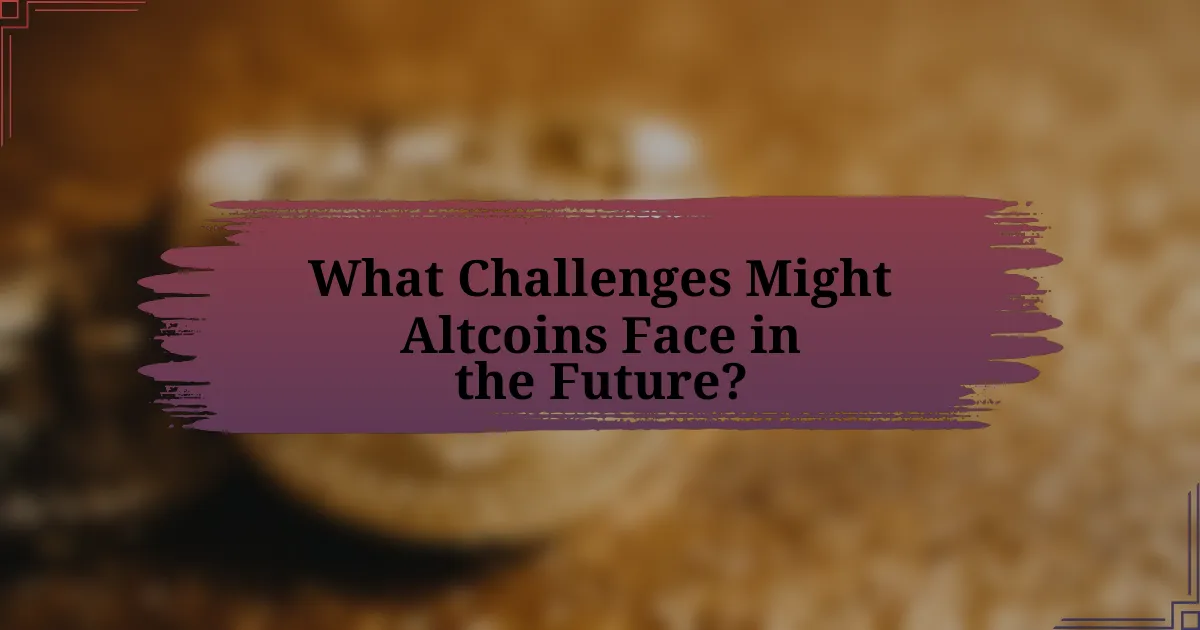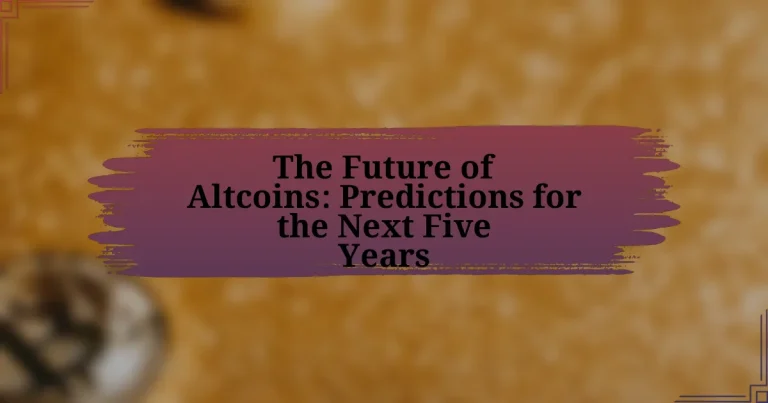Altcoins, which are cryptocurrencies other than Bitcoin, play a crucial role in the evolving blockchain ecosystem, offering diverse functionalities such as smart contracts and decentralized finance (DeFi). This article examines the significance of altcoins for the future, highlighting their differences from Bitcoin, key characteristics, and the factors driving investor interest. It also explores current trends shaping the altcoin market, the impact of technological advancements, and the challenges posed by regulatory scrutiny. Additionally, the article provides insights into market dynamics, potential risks for investors, and strategies for navigating the altcoin landscape, ultimately predicting the future trajectory of altcoins over the next five years.

What are Altcoins and Why are They Important for the Future?
Altcoins are cryptocurrencies other than Bitcoin, including Ethereum, Ripple, and Litecoin, which serve various purposes within the blockchain ecosystem. They are important for the future because they offer diverse functionalities, such as smart contracts, decentralized finance (DeFi), and enhanced transaction speeds, which can drive innovation and adoption in the cryptocurrency space. The growing market for altcoins, which accounted for approximately 40% of the total cryptocurrency market capitalization as of October 2023, indicates their potential to shape financial systems and provide alternatives to traditional banking.
How do Altcoins differ from Bitcoin?
Altcoins differ from Bitcoin primarily in their underlying technology, purpose, and market capitalization. While Bitcoin operates on a decentralized network primarily as a digital currency and store of value, altcoins often serve various functions, such as enabling smart contracts, facilitating decentralized applications, or providing specific utility within their ecosystems. For instance, Ethereum, a leading altcoin, allows developers to create decentralized applications through its smart contract functionality, which Bitcoin does not support. Additionally, Bitcoin has the largest market capitalization in the cryptocurrency space, while altcoins typically have lower market caps, leading to higher volatility and different investment risks.
What are the key characteristics that define Altcoins?
Altcoins are defined by several key characteristics that distinguish them from Bitcoin. Firstly, they often aim to improve upon Bitcoin’s limitations, such as transaction speed and scalability. For example, Ethereum introduced smart contracts, enabling decentralized applications, while Litecoin offers faster transaction times. Secondly, many altcoins utilize different consensus mechanisms, like Proof of Stake, which can enhance energy efficiency compared to Bitcoin’s Proof of Work. Additionally, altcoins frequently target specific use cases or industries, such as Ripple for cross-border payments or Chainlink for decentralized oracles. These characteristics highlight the diversity and innovation within the altcoin market, reflecting the ongoing evolution of cryptocurrency technology.
Why do investors consider Altcoins as a viable alternative?
Investors consider Altcoins as a viable alternative due to their potential for higher returns and diversification benefits compared to Bitcoin. Altcoins often introduce innovative technologies and use cases, such as smart contracts and decentralized finance, which can attract investment. For instance, Ethereum, a leading Altcoin, has seen significant adoption for its smart contract capabilities, resulting in a market capitalization that ranks second only to Bitcoin. Additionally, the growing number of projects and applications in the Altcoin space provides investors with various opportunities to capitalize on emerging trends in the cryptocurrency market.
What trends are currently shaping the Altcoin market?
Current trends shaping the Altcoin market include increased institutional investment, the rise of decentralized finance (DeFi), and the growing importance of regulatory clarity. Institutional investment has surged, with major firms allocating capital to altcoins, indicating a shift in market perception and potential for long-term growth. The DeFi sector has expanded significantly, with platforms offering innovative financial services that leverage altcoins, driving demand and usage. Additionally, regulatory developments are influencing market dynamics, as clearer guidelines can enhance investor confidence and attract more participants to the altcoin ecosystem. These trends collectively indicate a maturation of the altcoin market, positioning it for future growth and integration within the broader financial landscape.
How is technology influencing the development of new Altcoins?
Technology is significantly influencing the development of new Altcoins by enabling innovative features and improving scalability. For instance, advancements in blockchain technology, such as sharding and layer-2 solutions, allow for faster transaction speeds and lower fees, which attract developers to create new Altcoins that can address specific market needs. Additionally, the rise of decentralized finance (DeFi) platforms has spurred the creation of Altcoins that facilitate lending, borrowing, and trading without intermediaries, showcasing how technological progress directly shapes the cryptocurrency landscape.
What role do regulatory changes play in the future of Altcoins?
Regulatory changes significantly influence the future of Altcoins by shaping their legal status, market accessibility, and investor confidence. As governments worldwide implement new regulations, they can either foster innovation by providing clear guidelines or stifle growth through restrictive measures. For instance, the European Union’s Markets in Crypto-Assets (MiCA) regulation aims to create a comprehensive framework for digital assets, which could enhance legitimacy and attract institutional investment. Conversely, stringent regulations in countries like China have led to outright bans on cryptocurrency trading, negatively impacting market dynamics. Thus, the evolving regulatory landscape will be crucial in determining the viability and adoption of Altcoins in the coming years.

What Predictions Can Be Made for Altcoins Over the Next Five Years?
Predictions for altcoins over the next five years indicate a potential increase in adoption and market capitalization, driven by technological advancements and regulatory clarity. As decentralized finance (DeFi) and non-fungible tokens (NFTs) gain traction, altcoins that support these ecosystems, such as Ethereum and Binance Smart Chain tokens, are likely to see significant growth. Historical data shows that altcoins have outperformed Bitcoin during bullish market cycles, suggesting that a similar trend may occur as institutional interest in cryptocurrencies expands. Additionally, the increasing integration of blockchain technology in various industries could lead to a broader acceptance of altcoins, further enhancing their value and utility.
How will market dynamics affect Altcoin valuations?
Market dynamics will significantly influence Altcoin valuations through factors such as supply and demand, investor sentiment, and regulatory changes. For instance, when demand for specific Altcoins increases due to market trends or technological advancements, their valuations typically rise. Conversely, if negative sentiment arises from regulatory scrutiny or market downturns, Altcoin prices can decline sharply. Historical data shows that during the 2017 cryptocurrency boom, many Altcoins experienced substantial price increases as investor interest surged, demonstrating the direct correlation between market dynamics and valuation changes.
What factors will drive demand for specific Altcoins?
Demand for specific Altcoins will be driven by factors such as technological innovation, market adoption, regulatory developments, and investor sentiment. Technological innovation, including advancements in blockchain technology and unique use cases, can enhance the utility and appeal of certain Altcoins, leading to increased demand. Market adoption, evidenced by partnerships with established companies and integration into existing financial systems, can also significantly boost interest and usage. Regulatory developments, such as favorable legislation or clarity in regulations, can create a more secure environment for investment, attracting more participants to specific Altcoins. Lastly, investor sentiment, influenced by market trends, social media, and community engagement, plays a crucial role in shaping demand, as positive sentiment can lead to increased buying activity.
How might investor sentiment shift in the coming years?
Investor sentiment is likely to shift towards increased optimism in the coming years, driven by advancements in blockchain technology and regulatory clarity. As more institutional investors enter the altcoin market, confidence is expected to grow, leading to higher demand and investment. Historical trends indicate that periods of technological innovation, such as the rise of decentralized finance (DeFi) and non-fungible tokens (NFTs), have previously correlated with positive shifts in investor sentiment. Additionally, as governments establish clearer regulations around cryptocurrencies, this transparency may further enhance investor trust and participation in the altcoin space.
What technological advancements are expected to impact Altcoins?
Technological advancements such as layer-2 scaling solutions, interoperability protocols, and decentralized finance (DeFi) innovations are expected to significantly impact Altcoins. Layer-2 solutions, like the Lightning Network for Bitcoin and Optimistic Rollups for Ethereum, enhance transaction speeds and reduce costs, making Altcoins more efficient. Interoperability protocols, such as Polkadot and Cosmos, facilitate communication between different blockchains, allowing Altcoins to leverage each other’s strengths and expand their use cases. Additionally, the growth of DeFi platforms is driving demand for various Altcoins, as they provide new financial services and opportunities for users. These advancements collectively enhance the functionality, usability, and market adoption of Altcoins in the evolving cryptocurrency landscape.
How will blockchain innovations influence Altcoin development?
Blockchain innovations will significantly influence Altcoin development by enhancing scalability, security, and interoperability. For instance, advancements such as sharding and layer-2 solutions are expected to improve transaction speeds and reduce costs, making Altcoins more viable for everyday use. Additionally, innovations like cross-chain protocols will enable Altcoins to interact seamlessly with various blockchain networks, fostering a more integrated ecosystem. The rise of decentralized finance (DeFi) platforms has also driven the creation of new Altcoins tailored for specific financial services, reflecting the growing demand for specialized functionalities. These trends indicate that Altcoin development will increasingly align with the latest blockchain technologies, ensuring their relevance and competitiveness in the evolving cryptocurrency landscape.
What role will decentralized finance (DeFi) play in the future of Altcoins?
Decentralized finance (DeFi) will significantly enhance the utility and adoption of altcoins in the future. As DeFi platforms provide financial services such as lending, borrowing, and trading without intermediaries, they create new use cases for altcoins, driving demand and liquidity. For instance, the total value locked (TVL) in DeFi protocols has surged, reaching over $80 billion in 2021, indicating a growing reliance on these platforms. This trend suggests that altcoins integrated into DeFi ecosystems will likely see increased market relevance and valuation, as they become essential for transactions and governance within these decentralized applications.

What Challenges Might Altcoins Face in the Future?
Altcoins may face significant challenges in the future, including regulatory scrutiny, market volatility, and competition from established cryptocurrencies. Regulatory scrutiny is increasing as governments worldwide seek to implement stricter regulations on digital assets, which could hinder the growth and adoption of altcoins. Market volatility remains a persistent issue, as altcoins often experience larger price fluctuations compared to Bitcoin, making them riskier investments. Additionally, competition from established cryptocurrencies, particularly Bitcoin and Ethereum, poses a threat to the market share and relevance of altcoins, as these dominant players continue to innovate and capture investor interest.
How could regulatory scrutiny impact Altcoin growth?
Regulatory scrutiny could significantly hinder Altcoin growth by imposing stricter compliance requirements and limiting market access. When governments and regulatory bodies increase oversight, they often introduce regulations that require Altcoin projects to adhere to specific legal frameworks, which can lead to increased operational costs and complexity. For instance, the SEC’s actions against various cryptocurrency projects have resulted in many Altcoins facing legal challenges, causing uncertainty among investors and developers. This uncertainty can stifle innovation and deter new projects from entering the market, ultimately slowing down the overall growth of Altcoins.
What potential risks do Altcoin investors need to be aware of?
Altcoin investors need to be aware of several potential risks, including market volatility, regulatory changes, and security vulnerabilities. Market volatility is significant, as altcoins can experience drastic price fluctuations; for instance, in 2021, some altcoins saw price drops exceeding 80% within weeks. Regulatory changes pose a risk because governments worldwide are increasingly scrutinizing cryptocurrencies, which can lead to sudden market shifts or bans, as seen in China’s crackdown on crypto mining in 2021. Security vulnerabilities are also critical, as altcoins can be susceptible to hacks and scams; for example, in 2020, the DeFi platform Harvest Finance lost $33 million due to a flash loan attack. These factors collectively highlight the inherent risks associated with investing in altcoins.
How might market volatility affect Altcoin adoption?
Market volatility can significantly hinder Altcoin adoption by creating uncertainty and risk for investors. When prices fluctuate dramatically, potential users may hesitate to invest in or utilize Altcoins, fearing losses or instability. Historical data shows that during periods of high volatility, such as the 2017 cryptocurrency boom and subsequent crash, many investors withdrew from the market, leading to decreased adoption rates. Additionally, a study by Chainalysis in 2021 indicated that market volatility directly correlates with reduced transaction volumes in Altcoins, as users prefer more stable assets. Thus, sustained volatility can deter new users and slow the overall growth of Altcoin adoption.
What strategies can investors employ to navigate the Altcoin landscape?
Investors can employ several strategies to navigate the Altcoin landscape, including thorough research, diversification, and risk management. Conducting comprehensive research on the fundamentals, technology, and use cases of various altcoins allows investors to make informed decisions. Diversification across multiple altcoins can mitigate risks associated with the volatility of individual assets, as evidenced by the historical performance of diversified cryptocurrency portfolios. Additionally, implementing risk management techniques, such as setting stop-loss orders and only investing a small percentage of capital in high-risk assets, can protect investors from significant losses. These strategies are essential for successfully navigating the unpredictable nature of the altcoin market.
How can investors identify promising Altcoin projects?
Investors can identify promising Altcoin projects by analyzing their technology, team, market potential, and community engagement. Evaluating the underlying technology involves assessing the project’s whitepaper, which should clearly outline its purpose, use cases, and technical specifications. The team behind the project is crucial; a strong team with relevant experience and a track record in the blockchain space increases the likelihood of success. Market potential can be gauged by examining the problem the Altcoin aims to solve and its competitive landscape, including existing solutions and market demand. Lastly, active community engagement, reflected in social media presence and developer activity on platforms like GitHub, indicates a project’s viability and support. These factors collectively provide a comprehensive framework for investors to evaluate Altcoin projects effectively.
What best practices should be followed when investing in Altcoins?
When investing in Altcoins, it is essential to conduct thorough research on the project, its team, and its technology. Investors should analyze the whitepaper, assess the use case, and evaluate the market demand for the coin. Additionally, diversifying the investment portfolio across multiple Altcoins can mitigate risks associated with volatility. According to a report by CoinMarketCap, over 10,000 Altcoins exist, highlighting the importance of careful selection. Furthermore, investors should stay updated on market trends and regulatory developments, as these factors can significantly impact Altcoin performance. Utilizing secure wallets for storage and only investing what one can afford to lose are also critical best practices.
What are the key takeaways for the future of Altcoins?
The key takeaways for the future of Altcoins include increased regulatory scrutiny, technological advancements, and evolving market dynamics. Regulatory bodies are likely to impose stricter guidelines, which could impact the development and adoption of various Altcoins. Technological advancements, such as improvements in blockchain scalability and interoperability, will enhance the functionality and appeal of Altcoins. Additionally, market dynamics will shift as institutional investment grows, leading to greater legitimacy and potential for mainstream adoption. Historical trends indicate that Altcoins often follow Bitcoin’s market movements, suggesting that their future performance may be closely tied to Bitcoin’s trajectory.
How can investors prepare for the evolving Altcoin market?
Investors can prepare for the evolving Altcoin market by diversifying their portfolios and staying informed about market trends. Diversification reduces risk by spreading investments across various altcoins, which can mitigate losses if one asset underperforms. Staying informed involves regularly following news, market analyses, and technological advancements related to altcoins, as these factors significantly influence market dynamics. For instance, the rise of decentralized finance (DeFi) and non-fungible tokens (NFTs) has reshaped the altcoin landscape, highlighting the importance of adapting investment strategies to emerging trends.
What common pitfalls should be avoided in Altcoin investments?
Common pitfalls to avoid in Altcoin investments include investing without thorough research, falling for hype, and neglecting security measures. Investors often make the mistake of purchasing Altcoins based solely on social media trends or celebrity endorsements, which can lead to significant losses. For instance, the 2017 ICO boom saw many investors lose money on projects that lacked solid fundamentals. Additionally, failing to secure wallets and accounts can result in theft, as evidenced by numerous high-profile hacks in the cryptocurrency space. Therefore, conducting comprehensive due diligence, understanding the technology and team behind the Altcoin, and implementing robust security practices are essential to mitigate risks.




